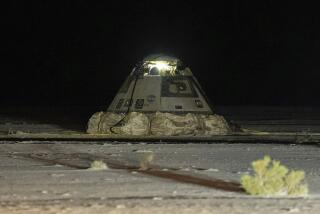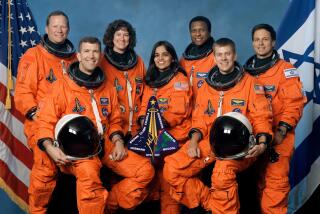Astronauts Use Shuttle Arm to Inspect a Tile
- Share via
HOUSTON — Columbia’s crew used the shuttle’s 50-foot robot arm Saturday to inspect a broken heat-shield tile, worked to fix a balky experiment and exercised for medical research.
Shuttle commander Daniel C. Brandenstein, co-pilot James D. Wetherbee, and mission specialists Bonnie J. Dunbar, Marsha S. Ivins and G. David Low accomplished one of the primary goals of the 10-day flight on Friday by retrieving the Long Duration Exposure Facility, an 11-ton science satellite that otherwise would have fallen into Earth’s atmosphere in early March.
On Saturday, the astronauts played a prank, beaming home a picture of “killer tomatoes” attacking LDEF, which carried among its 57 experiments a study of the effects of space radiation on 14-million tomato seeds.
“We saw something that was kind of strange so we got it on the cam-recorder and we thought we’d show it to you,” Brandenstein joked, after the doctored picture was broadcast to the theme of the movie “Attack of the Killer Tomatoes.” Brandenstein’s 22-year-old daughter, Adelle, had sent a greeting to the crew asking: “Have the killer tomatoes attacked yet?”
Brandenstein, a veteran of two previous flights and chief of the astronaut corps, also was asked during a news conference from space about a report that quoted his mother as saying he would not fly again.
“Is somebody looking for my job or what?” he joked. He then attributed the report “to a mother’s wishful thinking.”
One experiment, involving melting and resolidifying a metal, broke Friday and remained shut down Saturday while scientists analyzed the problem.
Flight director Al Pennington said overheating probably caused a crack in a sealed glass container of the element indium, a metal that melts at a relatively low temperature.
Columbia, with LDEF locked inside its payload bay, is scheduled to glide to a landing at 2:57 a.m. Friday at Edwards Air Force Base, Calif.






